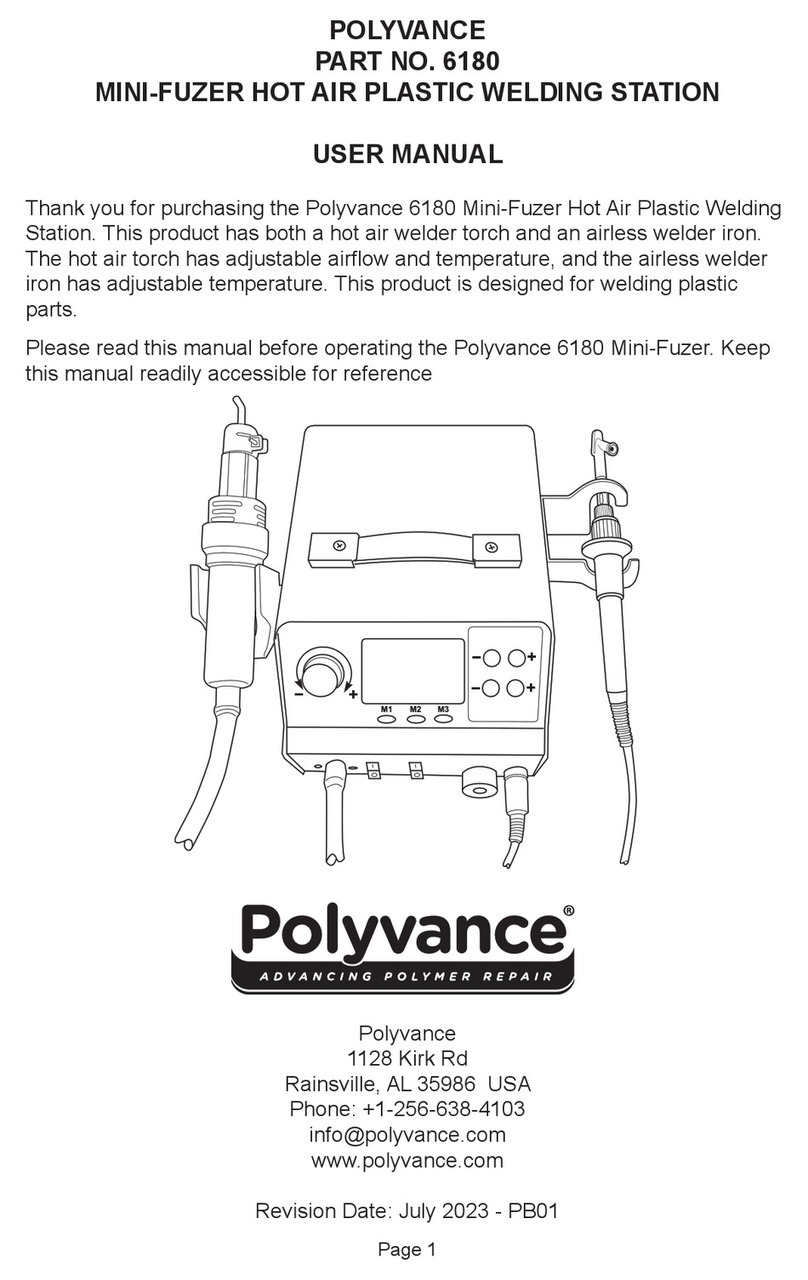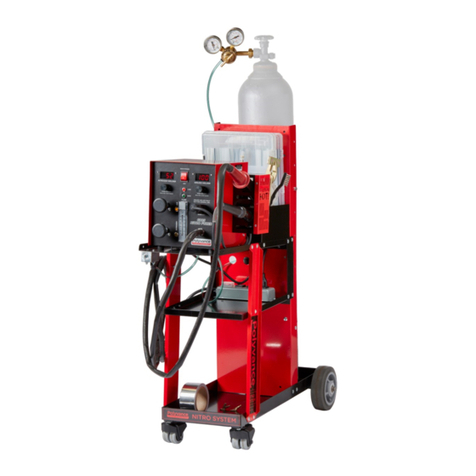
Page 2 Page 3
1. Most bumper repairs can be done with the air/nitrogen ow set at 12 LPM,
but up to 15 LPM is commonly used. The chart above may be used as a
general guide for welding various materials. Using settings outside the range
on the chart is generally not needed, unless you are welding unusually thin or
thick material or if the material you are welding has an unusually high or low
melting point.
It’s important to note that when increasing the temperature without increasing
the airow, the heating element can be over-heated easily, causing a dramatic
reduction in the life-span of the element. Over-heating is indicated by a
glowing outer steel torch barrel. If this happens, immediately turn down the
temperature and turn up the air and nitrogen ow. If an over-heat condition
continues uncorrected, the heating element will burn out and the handle may
be destroyed by the excessive heat becoming a potential re hazard.
2. To change from air to nitrogen, simply turn the selector valve to the desired
source. Be sure to switch back to the air setting when the weld is complete to
avoid using excess nitrogen.
3. Once the welder has warmed up, welding is accomplished by directing
the heated nitrogen at the intersection of the area to be repaired on the
base material and the welding rod. The welding rod should be applied
perpendicular to the base material with the welder aimed at approximately a
45° angle between the two.
4. The substrate should begin to gloss over in 3 to 5 seconds after applying
the heat. At this point, begin pressing the rod downward onto the surface,
rolling it towards the heat. Be sure the surface of the rod and the surface of
the substrate are both melted when pushing the two materials together.
For more information on welding plastic, please watch the instructional videos
found at www.polyvance.com.
7. Adjust the nitrogen regulator on the
nitrogen bottle to read between 20 - 50 psi.
8. With the selector valve turned to AIR,
use the AIR ow valve on the front of the
welder to adjust the ow of air so the ow
gauge reads 12 LPM. At this setting, the
ball will oat halfway between the 10 and
15 LPM lines.
9. With the selector valve turned to N2,
use the N2 ow valve on the front of the
welder to adjust the ow of nitrogen so the
ow gauge reads 12 LPM.
10. Turn the selector valve back to AIR.
Always select AIR when the welder is idle
to conserve nitrogen!
11. On the back of the welder, turn on the
main power.
12. Check to make sure the green
“PRESSURE SAFE” light is on. The
welder will not heat if the “PRESSURE
SAFE” light is not on. If the light does
NOT illuminate when the airow is over 10
LPM, contact Polyvance tech support for
the adjustment procedure.
13. Turn on the nitrogen and airless
welders by rotating their respective control
knob clockwise. Start with the nitrogen
welder set about halfway up the dial, then
allow the welder to warm up for 5 to 10
minutes. If the welder is not hot enough to
weld, turn the welder up in incrementally
giving it time to preheat before increasing
the temperature further. Once a
satisfactory temperature is reached, it can
be simply turned to the same temperature
and airow setting immediately the next
time the welder is used.
14. After the welder has had a chance to
preheat, turn the selector valve to N2 to
begin welding. Be sure to turn the valve
back to AIR when the weld is complete.
Forgetting to turn the valve back to AIR will
consume a large amount of nitrogen and
will empty your nitrogen bottle in a short
amount of time.
Type of Plastic Melting Temp. Series of
Welding Rod
Approximate Temperature
Setting on Nitrogen Welder
Air Flow
LPM
Polyurethane (RIM, PUR) N.A. R01 7-10 (AIRLESS WELDER ONLY) N.A.
Polypropylene (PP) 160-166 °C (320 -331 °F) R02 7 12 - 15
ABS 105 (221°F) R03 6 12 - 15
Polyethylene (LDPE) 105-115 °C (221-239 °F) R04 7 12 - 15
TPO 177°C (350°F) R05 7 12 - 15
Nylon (PA) 269°C (516°F) R06 8 12 - 15
Polycarbonate (PC) 155°C (311°F) R07 7- 12 - 15
PVC 177°C (350°F) R09 7- 12 - 15
Polyethylene (HDPE) 190°C (375°F) R12 7+ 12 - 15
PET 254°C (490°F) R13 8- 12 - 15
ASA 220°C (428°F) R14 7+ 12 - 15
GTX 275-300°C (527-572°F) R15 8+ 12 - 15
Temperature Setting Suggestions*
* Most welding operations will be close to the recommended settings. Welding outside
the recommended range may be needed if the plastic being welded is very thin or thick
or if a higher or lower airow is used. Extreme care must be taken to avoid overheat-
ing the element.
Welding Basics:
CAUTION: A LWAY S maintain adequate airow through
the welder while it is hot or the power is on. Failure to do
so will burn out your heang element. Polyvance DOES
NOT WARRANT the heang element because its life is
completely under YOUR control.
1
2
3
4
87
9a
12 LPM
11
Set between 20
and 50 psi
12 LPM
10
12 13a
14
9b
13b






















